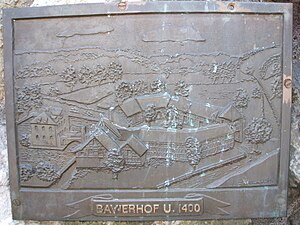House Bavier
| House Bavier | ||
|---|---|---|
|
Bronze plaque on the Bavierstein |
||
| Castle type : | Niederungsburg | |
| Conservation status: | Demolished in the 1960s | |
| Place: | Erkrath | |
| Geographical location | 51 ° 13 '17.9 " N , 6 ° 54' 34" E | |
|
|
||
House Bavier (in old sources also Buer , Buir or Buyr ) was a medieval aristocratic seat in the form of a low castle in Erkrath . The house is considered to be the nucleus of Erkrath.
Naming
The house has had different names over the years. In the 12th century it first appeared as a Erkerode (the ending -rode indicates a yard on cleared land). Then in the 14th and beginning of the 15th century as Schletzgut or Schletthausen after the owners at that time, the Lords of Schletz ( Sletz ). When the house came to the von Buer gentlemen in 1515 , they named it after their name. H. after their former headquarters in Burg Buer in Gelsenkirchen-Buer . Towards the end of the 16th century, however, the family "translated" their name into High German to Bawyr , Bavier , Baur or Bauer , so that House Buer became House Bavier . This name has been preserved to this day and can be found e.g. B. in an Erkrath street name ( Bavierstraße ) again.
history
Due to its location in a former wetland, it is assumed that the complex was previously fortified by a moat. The house appears for the first time as the Franconian Adelshof Erkerode in 1147. In 1189 it appears as a moated castle and knight seat of Daniel de Erkerode . In 1221 a Konrad von Erkrath ( Erkerohde ) is mentioned. His mother was a sister of the nobleman Heinrich von Denn ( Danne ). In 1367 the house appears as the seat of a knight von Schönrath .
The house was initially named after the owners at the end of the 14th / beginning of the 15th century, the Schletz family . Diedrich Sletz appears in a feud letter from the Kalkum feud in 1405 . After Dietrich von Bottlenberg called Kessel bought the house in 1461 but died childless, the Kessel heirs sold the house in 1515 to Hermann von Buer, who in turn bequeathed it to his descendants. The house remained in the hands of the von Buer family from 1515 to 1736, who renamed it Haus Buer . In the course of time, the spelling Haus Bavier established itself in the Erkrath area .
The owners after the von Buer family included the barons Schall von Bell and von Beveren as sons-in-law of Anna Elisabeth von Bodelschwingh (after 1738), who was married to Hermann Sigismund von Buer. In 1752 Chamberlain and Councilor Jakob Tillmann von Koch acquired the house. In December 1783, Baron Leopold Pelagius was Alohsius of Beroldingen for home Bavier been sworn in , and in November 1787 Ferdinand Freiherr von Sparr to Greiffenberg . The last noble owners from the von Reiner and von Capitolo families had the house auctioned in 1804. The auction was announced on June 12, 1804 in the weekly Düsseldorfer Nachrichten. On July 3, 1804, the bourgeois Wilhelm Nothen was awarded the bid for 20,550 Reichstaler. The buyer divided the property. House Bavier and about 50 acres from the property went to Thomas Struncksberg for 6,907 Reichstaler and 21 3/4 Stüber, who sold Haus Bavier to Wilhelm Schallbroich for 13,000 Reichstaler on March 21, 1806. His daughter Sibilla brought the house into the marriage with Wilhelm Heinrich Lüngen. His family has kept the house and land in their possession since then.
After the turn of the century, the purely agricultural house was leased to Julius Kotthaus, and from October 1953 to Otto von Danwitz . The house was used for agriculture until the early 1960s. Then it had to give way to the Erkrath urban development. It was torn down. In 1962 residential buildings and several shops were built there (on Gerberstrasse, Bavierstrasse and Bahnstrasse).
In 1992 the Erkrath Heimatverein Ercroder Jonges donated a memorial, the so-called Bavierstein . The stone that comes from the house was provided with bronze picture and writing panels and was given its final place at the northeast corner of Bavierstrasse.
literature
- Horst Osmann: On the history of the former Bavierhof. In: Usser Dorp - Association magazine of the Ercroder Jonges 1982 eV, Edition 7, Erkrath 1996, pp. 13-22.
- Dietmar Ahlemann: The Lords of Buer - A West German Family History from the High Middle Ages to the 19th Century. In: West German Society for Family Studies eV (Ed.): Yearbook 2012, Volume 274, Cologne 2012, pp. 213-300.
Web links
- Entry by Günter Krause and Jens Friedhoff about Bavierhof in the scientific database " EBIDAT " of the European Castle Institute
Individual evidence
- ↑ Kurt Niederau , Aline Poensgen (arrangement): Gräfrath Monastery, documents and sources 1185-1600 , in: Anchor and Sword, Volume 11, Solingen 1992, p. 23, No. 20.
- ↑ Heinrich Ferber : The Calkumschen feuds with the city of Cologne . In: DJB Vol. 8, Düsseldorf 1894, p. 67.




